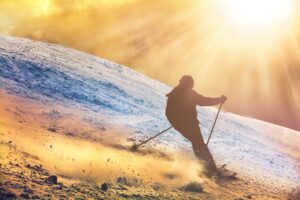We’re in the middle of another Minnesota winter, and that gives us the opportunity to partake in some fun seasonal activities. Skiing and snowboarding are two of the most common wintertime activities in Minnesota, and while it can be quite fun to hit the slopes with friends and family, the activity also sends countless people to their doctor with neck and back injuries. Not all of these injuries are easily preventable, but if you take a smart approach to the ski slopes, you can reduce your risk of a neck or spine injury this winter. Below, we share six tips for protecting your neck and spine when skiing or snowboarding.
Neck And Spine Safety Tips When Skiing
It doesn’t matter whether you’re a novice skier or you routinely head down the double black diamond runs, everyone can better protect their spines if they keep these tips in mind when skiing.
- Stretch – Before you step into your ski boots or jump on the chairlift, take a few minutes to stretch your body. You put a lot of stress on your legs and spine when you’re twisting and navigating your way down the ski hill, and if your body isn’t adequately prepared for this strain, your day may be over before it really begins. Stretch your whole body, with extra focus on your neck, spine, hips and legs.
- Protective Gear – Make sure that you have the right safety gear to reduce your risk of a fall or a severe injury. Wear bright colors so that you’re easy to see on the slope, and make sure to wear goggles and a helmet so that you can always clearly see where you’re going and to protect your head and neck in the event of a fall. You can even consider wearing a spine protector to reduce your risk of a vertebral fracture in the event of a fall.
- Stay Within Your Skill – A number of injuries on the ski slopes occur because people head down a path that is too advanced for their skill level. Start with some easier runs to learn more about the course conditions before moving up to more difficult terrain.
- Avoid The Moguls – It may be cool to watch those Olympic athletes navigate quickly down the bumpy terrain called moguls, but they are a recipe for injury if you are not careful. The stress of navigating down the moguls is felt heavily on your knees and your spine, and if you lose control or get out of a nice rhythm, you can end up putting an immense amount of strain on your spine. Unless you really know what you are doing, your knees and your spine will thank you for avoiding the mogul course.
- Be Aware Of Your Surroundings – You may be very graceful on your skis or snowboard, but odds are you’ll be sharing the hill with others who are not as skilled, so you need to keep your head on a swivel and be mindful of others. Don’t assume that other skiers or snowboarders will always act rationally or within the rules of the hill. A number of neck and back injuries occur each year as a result of collisions between skiers.
- Listen To Your Body – Finally, get in the habit of listening to your body when you’re skiing or snowboarding. If something just doesn’t feel right, you tweaked a muscle or you’re just starting to get fatigued, take a short break. Tired and overworked spinal muscles are at an increased risk of strains, cramps and tears, so listen to the signs your body is giving off that it needs a break. This is especially true early in the season when our bodies are still getting used to handling the physical strain of the seasonal activity.
If your back is hurting after a day on the slopes, or you suffer a fall and are injured, consider connecting with Dr. Jackman and the team at The Midwest Spine & Brain Institute. We’ll be able to diagnose your injuries and set you up with an individualized treatment plan to help you recover and get back on the slopes in short order. For more information, or for questions about a different spinal issue, reach out to Dr. Jackman and his team today at (651) 430-3800.


 5 Neck Problems Caused By Regular Cell Phone Use
5 Neck Problems Caused By Regular Cell Phone Use